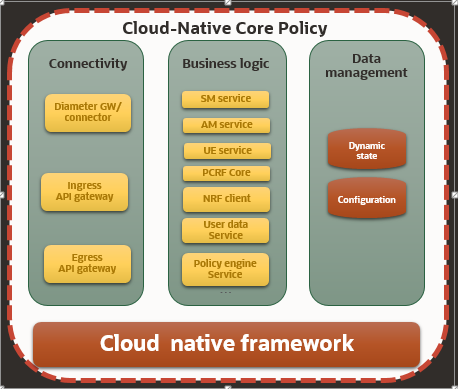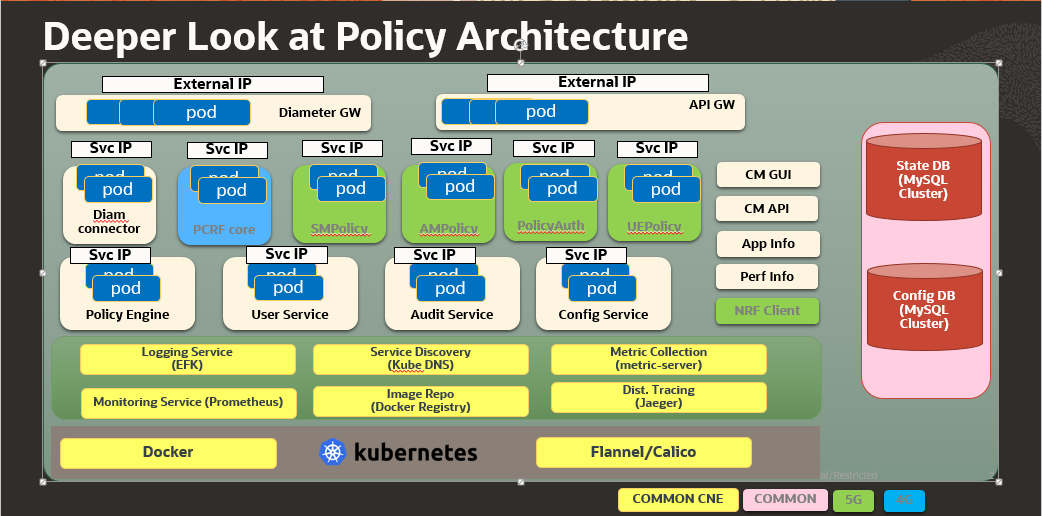2 Cloud Native Core Policy Architecture
- Connectivity: Components interfacing with external entities. This is where an API gateway is utilized to interface with external traffic to the PCF. These are stateless sets of components.
- Business logic: Application layer running the PCRF/PCF business logic, policy engine and various services that can be enabled based on deployment needs. These are stateless sets of components.
- Data Management: Data layer responsible for storing various types of persistent data. The PCF is built to be able to plug in different types of backend data layers that could be internal or external.

As a result, an actual policy function can be composed of the necessary micro-services to provide the desired service, For Example, PCF, PCF/PCRF, a subset of a PCF (For Example, one without usage monitoring, etc.).
Oracle Communication Cloud Native Core Policy solution takes the policy designing
experience to the next level by providing ultimate flexibility, extensibility,
modularization to rapidly and securely deploy new policies supporting different and
existing use cases. The Converged policy solution supports both 4G and 5G networks,
thereby helping operators to manage their heterogeneous network in an intuitive and
consistent manner while enabling seamless interworking and migration between 4G and 5G.
Below is the Cloud Native Core Policy architecture diagram:
- Kubernetes cluster hosting Docker containers and Calico networking
- Standard CNE services to support operation of the PCF
- Cloud Native Core Policy Application Services
- API GW (HTTP/2) – API Gateway service offers single entry to all HTTP/2 traffic to access policy services. The API gateway also plays a crucial role in traffic distribution, overload control and related ingress/egress services.
- Diameter Gateway/Connector – Enables the policy solution functions as a diameter server and offers integration over Gx, Rx, Sh, Sy and other legacy diameter services. Diameter server is also implements routing, load balancing and overload control services.
- Configuration Service and CM GUI offers graphical interface for all policy-related configurations and design of policies. The solution encapsulates internal details and provides a human-friendly interface for policy design.
- NRF Client Service, along with application info and performance info services, integrates with external NRF for service registration, discovery, and service status/ load related information.
- Cloud Native Core Policy Business Logic
- SM Service (includes PA Service) - The service (evolution of Gx) provides the SMF session and application/flow based policies. The policy authorization service (Rx like interface in SBA) authorizes an AF request and creates policies as requested by the NF consumer service for the PDU session to which the AF session is bound.
- AM Service - The service implements access management service-related policies over N15 interface towards the Access and Mobility Management Function (AMF).
- PCRF Core Service – The service implements the legacy handling of PCRF core business logic, interactions with other micro-services, and triggers for policy enforcement over the Gx interface.
- UE Policy Service - The PCF provides UE policy, including Access Network Discovery and Selection Policy (ANDSP) and UE Route Selection Policy (URSP) via the AMF transparently to the UE
- User Service - This service is an evolution of the 4G UDR/SPR where the PCF is able to retrieve, update, subscribe, and get notified to changes. The service implements integration with all external data sources including 5G UDR, CHF, LDAP Server, 4G Sh and Sy interfaces.
- Policy Engine – The heart of policy solution, policy engine, is a service that implements the policy defined business logic to perform all network policy behaviors and actions.
- Data Tier
- Dynamic state – Store session information relevant for policy context.
- Configuration store – Stores configuration related data